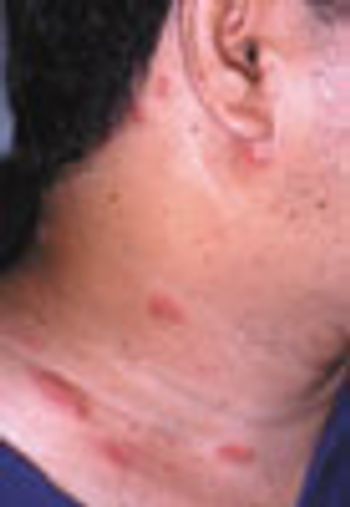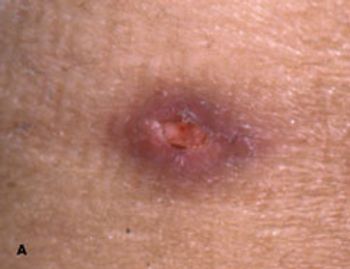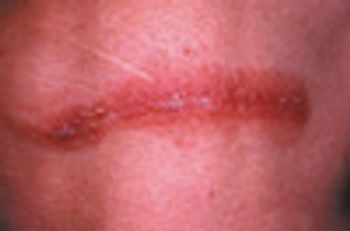
For 3 days, a 44-year-old man had several crops of tiny vesicles with raised erythematous bases on the right side of his neck and 2 elongated maculopapular lesions at the base of the neck. All of the lesions were within the C3 dermatome.

For 3 days, a 44-year-old man had several crops of tiny vesicles with raised erythematous bases on the right side of his neck and 2 elongated maculopapular lesions at the base of the neck. All of the lesions were within the C3 dermatome.

A 37-year-old man presents for evaluationof 3 reddish, tender, 2-cm, elevatedlesions on his right ankle that havefailed to respond to oral amoxicillin/clavulanate prescribed by anotherphysician. The lesions have beenpresent for 8 weeks. Each lesion has acentral opening and watery yellow drainage (Figure 1). The patient recentlyreturned from a trip to CentralAmerica, where he had sustained multiplemosquito bites.

35-year-old Hispanic man presented with nonproductive cough; dyspnea; fever; and a painful, ulcerated, 1.5-cm, red-brown plaque on the left flank. He had had the lesion for 3 months and the symptoms for 1 week. The patient had grown up in Arizona, and he traveled there 4 months before the lesion arose.

ABSTRACT: Prompt treatment of herpes zoster with an antiviral such as acyclovir does not prevent post-herpetic neuralgia, but it can reduce the pain and duration of the disorder, particularly in older patients. Agents used to treat post-herpetic neuralgia include gabapentin, tricyclic antidepressants, lidocaine patches, capsaicin, and opioids. Effective treatment often requires the use of multiple medications. When you select a regimen, consider whether your patient is at heightened risk for adverse drug effects and whether he or she has comorbid disorders, such as depression, that might be amenable to treatment with the same medication used for post-herpetic neuralgia. Patients with intense pain and dysfunction are more likely to have a protracted disease course; early, aggressive intervention is warranted in this setting. For patients who continue to have disabling pain despite treatment, consider intrathecal corticosteroid or lidocaine injections or referral to a pain management center or specialist.

One fact of life for pediatricians is that our patients grow up. One of our last contacts with our young adult patients who continue on to college may be their pre-college physical examination or their request for a college pre-matriculation immunization form. A pre-college visit provides a good opportunity to review the young adult's immunization status to be certain that he or she is up-to-date. That visit is also a good time to verify that the student has received a booster dose of tetanus toxoid within the past 10 years, a complete series of hepatitis B vaccine, and any other vaccine (such as varicella) that may be indicated.

A54-year-old white woman presentswith extremely tender,firm lesions on the right hip and legsthat have been increasing in size andnumber over the past few months.

This 10-year-old boy presented forevaluation of a rash that developedduring a spring vacation on Florida’sAtlantic coast. After he had beenswimming in the ocean, a pruritic,erythematous, papular rash developedon his trunk, axillae, and groin. Approximately24 hours after the onsetof the rash, he experienced malaise,chills, and a sore throat. His past medicalhistory was unremarkable. Hehad been fully immunized and hadhad varicella infection.

A 30-year-old man presentedwith severe left flankpain radiating to his abdomenand gross hematuriaof 5 to 10 days’ duration.He also reported a 4- to 6-monthhistory of nausea with intermittentvomiting, anorexia, and progressiveweight loss. He took no medicationsand had no allergies.

Backyard cookouts . . . picnics at the beach . . . these warm-weather pleasures can heighten your patients' risk of exposure to food-borne pathogens. An egg salad sandwich, left in the hot sun too long, can become a breeding ground for Salmonella, and undercooked burgers can harbor Escherichia coli O157:H7.

Routine inspection of the oral cavity is not a part of every patient encounter. There exist, nevertheless, clear indications for physical examination of the mucosal surfaces between the lips and the anterior tonsillar pillars; these include symptoms such as pain, erythema, and swelling that are referable to this area.

For 24 hours, a 62-year-old woman had had severe weakness, abdominal pain, and watery diarrhea that had become bloody in the past 12 hours.She had no significant medical history.

For 3 days, a 47-year-old woman had a painful red swelling on her finger.The patient--a cellist--had tried to lance the lesion at home, but itprogressively worsened and was now “throbbing.” She denied fever andnail biting.

This crusted eroded area on the lower lip of a 67-year-old man has been presentfor several months.Which of the following statements are true?A. This condition preferentially affects the lower lip.B. It is more common in women.C. It is more common in immunocompromised patients.D. It is more likely to metastasize than similar lesions on nonmucosal surfaces.E. 5-Fluorouracil is contraindicated in this location.

A mildly painful, nonpruritic rash on the forearms and legs prompted a 42-year-old man to go to the emergency department. The patient noted the rashwhen he awoke that morning. He had had joint pain and fever for the past7 days and generalized malaise with chills that began about 3 days earlier.He had no significant medical history.

A 78-year-old man presents with anasymptomatic acute eruption on bothlegs that extends from the ankles tojust above the knees. Individual maculesrange from 4 to 10 mm in diameterand from light brown to red. Almostall of the lesions have multiple,tiny, discrete red puncta.

A 79-year-old man presents to theemergency department with a painfullesion on his right forearm. Three daysearlier, he had scratched his arm whileremoving crabs from a trap. Initially,the scratch had bled slightly, and hehad self-treated with an over-the-counterantibiotic ointment and an adhesivebandage.

A 17-year-old adolescent experienced an episode of generalized paralysis ofacute onset after physical exertion and consumption of a high-carbohydratemeal. Despite a good appetite, the patient had lost between 2 and 3 lb duringthe past month. He complained of heat intolerance and palpitations and reportedlosing his temper easily.

ABSTRACT: Acute and recurrent cystitis in young women, once identified, can be treated empirically without microbiologic confirmation. In these women, a urine dipstick test that is positive for nitrates or leukocyte esterase is considered diagnostic. The usual treatment is a 3-day course of an antibiotic. Prophylaxis is recommended for women who have more than 3 episodes of cystitis per year. Options include postcoital prophylaxis with a single dose of antibiotic or long-term low-dose antimicrobial therapy. In young women with acute pyelonephritis, fluoroquinolones are the treatment of choice. Empiric therapy is initiated as soon as possible in patients at risk for complicated urinary tract infections (UTIs). Alternative techniques, such as intermittent catheterization, may reduce the incidence of UTIs in patients with indwelling catheters.

ABSTRACT: Acute scrotal pain, a high-riding testicle, and the absence of the cremasteric reflex on the affected side signal testicular torsion-a surgical emergency. The pain associated with torsion of the appendix testis is usually of gradual onset and is exacerbated by movement. The tenderness is often localized over the infarcted appendix, and the infarction may be visible through the scrotal skin (the "blue dot sign"). Pain associated with epididymitis is usually gradual in onset; the patient may complain of dysuria, increased frequency, and discharge, particularly if the causative pathogen is Chlamydia trachomatis or Neisseria gonorrhoeae. Hydroceles are smooth and nontender, and the scrotum transilluminates. If the scrotum does not transilluminate and compression of the fluid-filled mass toward the external ring completely reduces the mass, then a hernia is the more likely diagnosis. A patient with a varicocele typically complains of a sensation of heaviness and of "carrying a bag of worms."

Most sport-diving problems are mild and self-limited; however, serious or life-threatening situations can arise. In a previous article (CONSULTANT, June 2004, page 961), we addressed fitness and safety issues. In this article, we review the principal medical problems associated with sport diving.

A painful rash suddenly developed on the chest wall of an otherwise healthy 8-year-old girl. Examination of the rash revealed grouped vesicles with an erythematous base in a linear distribution along the T5 dermatome. The child had not been vaccinated with varicella vaccine and had had chickenpox 3 years earlier.

For more than 20 years, a 55-year-old man had a faintly erythematous, papulosquamousrash with arciform borders on his groin and waistline. The rashhad been treated with a variety of medications. Topical and oral antifungalsand antibiotics and topical corticosteroids had been used but to no avail. Nolaboratory tests had been performed.

For 1 year, a 30-year-old man had an intermittent rash that was confined to thearea of his jockey shorts; no other part of the body was affected. The patientreported that the pruritic eruption arose and disappeared spontaneously andwas more prominent during the heat of summer.

A 50-year-old man had a long-standing rash on both soles. The patient’s toenails were yellow and dystrophic. These physical findings strongly suggested moccasin-variety tinea pedis and onychomycosis.

For years, a 39-year-old man had an eruption on his hand, which seemed to becontrolled with topical corticosteroids. The patient was a rancher.